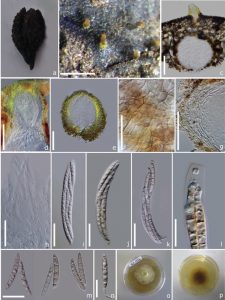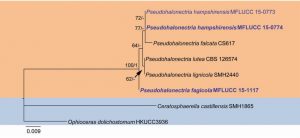Pseudohalonectria fagicola R.H. Perera, E.B.G. Jones & K.D. Hyde, sp. nov., Index Fungorum: IF 552161, Fig. 1a–p.
Etymology: In reference to the host genus Fagus, and cola meaning loving.
Holotype: MFLU 16-1085
Saprobic on beech cupules (Fagus sylvatica L.). Sexual morph: Ascomata 275–690 × 225–500 μm, solitary to less commonly aggregated, immersed with a protruding neck, globose to depressed globose, greenish yellow at first, becoming darkened with age, rostrate. Neck 90–390 × 70–160 μm, conical, composed of parallel hyphae, outer hyphae outwardly directed, subglobose with enlarged ends, greenish yellow, periphysate. Peridium 9–32 μm wide, membranous, 5–12 cell layers, inner layer composed pale yellow cells of textura angularis, outer cells pseudoparenchymatic, composed of darkened yellow, laterally compressed cells of textura angularis. Paraphyses 62–116 × 3.1–5.6 μm, 1–4-septate, wide at base, tapering towards the apex, thin-walled, attached to ascogenous hyphae. Asci 83–104 × 8.8–11 μm diam. (x̅ = 93 × 10 μm, n = 30), 8-spored, unitunicate, cylindrical, straight or sigmoidal, separating at the basal septum from ascogenous hyphae, thimble-shaped apical apparatus, J-. Ascospores 26–33 × 3.9–5.1 μm diam. (x̅ = 29 × 4.4 μm, n = 30), 4–6 (–7)-septate, overlapping uniseriate to biseriate, pale brown, pink/orange in mass, ellipsoidal, straight to curved, constricted or not-constricted at the septa, after discharge accumulating in a mass at the neck opening. Asexual morph: Undetermined.
Culture characters: Slow growing, reaching 3 cm diam. within 21 days incubation on PDA, at 16°C, circular, effuse, with regular margin, yellowish-green in center and hyaline towards the margin from above; reverse yellow green to brown.
Material examined: UK, Hampshire, Bishops Waltham, slightly anoxic, stagnant water, on beech cupules (Fagus sylvatica L.), 3 June 2015, E.B.G. Jones, GJ 177b (MFLU 16-1085, holotype, ibid. (GZ, isotype), ex-type living culture, MFLUCC 15-1117, GZCC.
Notes: Pseudohalonectria fagicola forms a separate clade (100% ML/PP) within the genus Pseudohalonectria as a sister taxon (Fig. 2) and shares some common characteristics, but differs in that it generally has smaller asci and ascospores. In P. lignicola asci (90–132 × 11–17.54 μm) and ascospores (38.4–74.8 × 3.5–6.5 μm) are larger. Pseudohalonectria fagicola is characterized by ellipsoidal 5–6(–7)-septate ascospores, while P. lignicola has 5–11 septa and cylindrical ascospores (Shearer 1989). Although the shape of the ascospores of P. fagicola is similar to P. lutea, they are smaller than ascospores of P. lutea (48–68 × 4.8–8.4 μm) (Shearer 1989). Pseudohalonectria fagicola differs from P. hampshirensis in its smaller ascomata. Pseudohalonectria hampshirensis has 0–3–4-septate, fusiform ascospores, while P. fagicola has 5–6(–7), ellipsoidal ascospores. Morphologically P. fagicola differs from other Pseudohalonectria species in the size of its ascomata, asci, ascospores and ascospore septation.

Fig. 1. Pseudohalonectria fagicola (MFLU 16-1085, holotype) a, b. Appearance of ascomata on host substrate. c. Longitudinal section through ascoma. d, e. Close up of the ostiole with periphyses. f. Peridium in surface view. g. Peridium. h. Paraphyses. i–k. Immature and mature asci. l. Ascus in Melzer’s reagent. m. Ascospores. n. Germinating ascospore. o, p. Cultures on MEA. Bars: b = 500 μm, c = 200 μm, d, e = 50 μm, f = 20 μm, g = 50 μm, h–k = 20 μm; l = 10 μm, m, n = 20 μm.

Fig. 2. Phylogram generated from maximum likelihood analysis based on combined LSU and SSU sequence data of the genus Pseudohalonectria. Maximum likelihood bootstrap support values greater than 50% and Bayesian posterior probabilities (PP) above 95% are shown near the nodes. The new isolates are in blue and ex-type sequences in bold. The tree is rooted with Ophioceras dolichostomum and Ceratosphaerella castillenses.
